Sports photography can prove pretty challenging without the right camera. Subjects move fast, and if your camera can’t keep up with the fast-paced movement, you’ll miss out on crucial moments.
That’s why you need a sports photography camera. But how do you identify the right camera if you’re just kick-starting your sports photography journey??
In this guide, we’ll provide you with a list of some of the best cameras for sports photography beginners to help you choose a suitable camera.
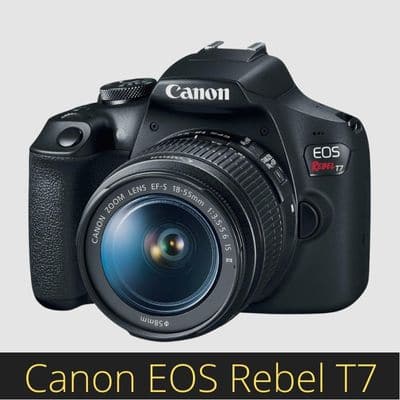
- Large 24.1 megapixel CMOS (APS-C) Sensor
- Digic 4+ Image Processor
- 9-point autofocus
- Optical Viewfinder with roughly 95% viewing coverage

- 16 megapixel low-light CMOS Sensor
- 24-2000mm zoom lens
- 2359K- dot eye-level electronic viewfinder (EVF)
- Dual Detect Optical VR (Vibration Reduction)
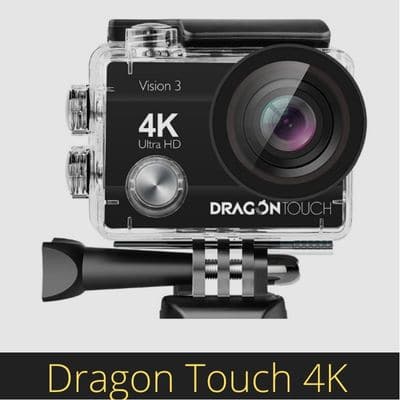
- Waterproof up to 100ft (30m)
- 170-degree wide-angle camera
- Maximum 4x zoom
- Free Mounting Accessories
Comparison Chart
| Best Sports Photography Camera for Beginners | Type | Sensor | Resolution | Weight |
|---|---|---|---|---|
| Canon EOS Rebel T7 Digital SLR Camera | DSLR | CMOS (APS-C) sensor | 24.1 MP | 1.05 lb |
| Nikon COOLPIX P950 | Bridge | 1/2.3″ BSI CMOS sensor | 16 MP | 2 lb |
| Dragon Touch 4K Action Camera | Action | BSI CMOS sensor | 16 MP | 0.33 lb |
| KODAK PIXPRO AZ421 Digital Camera | Bridge | 1/2.3″ CCD sensor | 16.15 MP | 0.98 lb |
| Panasonic LUMIX FZ300 Long Zoom Digital Camera | Bridge | 1/2.3″ MOS sensor | 12.1 MP | 1.52 lb |
| Fujifilm X-T4 Mirrorless Camera | Mirrorless | CMOS (APS-C) sensor | 26.1 MP | 1.34 lb |
| AKASO EK7000 Pro 4K Action Camera | Action | CMOS sensor | 16 MP | 0.13 lb |
| COOAU Native 4K 60fps 20MP Touch Screen Action Sport Camera | Action | CMOS sensor | 20 MP | 1.23 lb |
| Sony Alpha A6600 Mirrorless Camera | Mirrorless | CMOS (APS-C) sensor | 24.2 MP | 1.11 lb |
| OLYMPUS Tough TG-6 Waterproof Camera | Compact | BSI CMOS sensor | 12 MP | 0.56 lb |
10 Best Cameras for Sports Photography Beginners
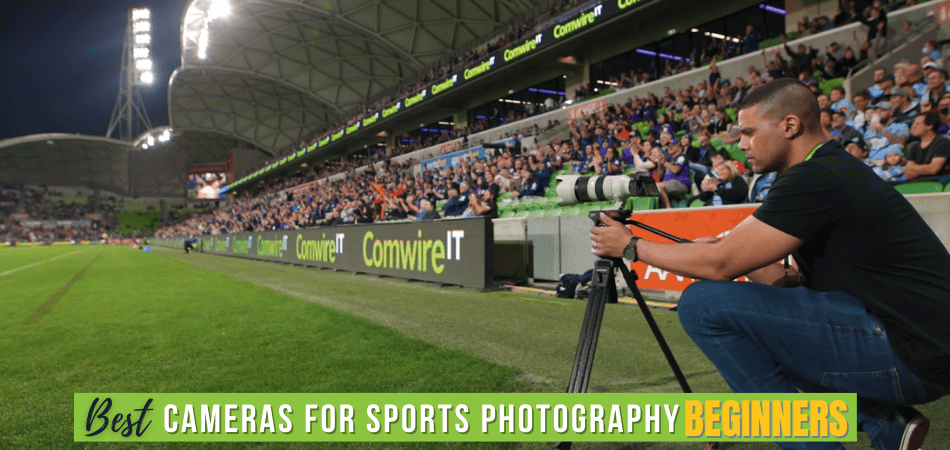
1. Canon EOS Rebel T7 Digital SLR Camera – Best Overall
The Canon EOS Rebel T7 is the successor to the T6. Perfect for beginners, it’s an affordable camera that will allow you to capture eye-catching photos with relative ease. Here are some of its key specifications.

Great Overall Design
The Canon Rebel T7 is one of the most miniature DSLR cameras on the market. It weighs around 1.75-lbs and measures about 5.1×3.9×3.1 inches. The four-way controller keypad and on/off switch are a little stiff, but all the dials and buttons are well marked. The external controls offer the user one-touch access to the camera’s interesting shooting parameters like white balance, focus, ISO, and drive modes.
Good Image Quality
You can expect well-saturated and bright colors, even with Standard and Auto picture styles. If you’re creating for a specific genre, like Landscape or Portrait, or in search of different looks, the Rebel T7 provides additional options such as Monochrome, Faithful, and Neutral as well as Saturation and Color Tone. Each parameter is adjustable within each specific style.
Sufficient Connectivity
If you download the Camera Connect app for Android and iOS, you’ll be able to quickly and easily transfer videos and pictures from your camera to your smartphone or tablet. The app will also allow you to take pictures remotely. The connectivity setup is easy, and its app is intuitive. You can use the GPS on your mobile device to choose the transferred image’s size and add location data.
Produces Quality Videos
Canon decide to stick with the basics with the Rebel 7 and kept with full HD (1920×1080 at 30fps), SD (640×480 at 30fps), and HD (1280×720 at 60fps). The movies you record will come in the MPEG4 AVC H264 format, which creates .MOV files that can be shared easily. The camera’s fully automatic mode allows for easy shooting, although.
Quality Overall Performance
Both autofocus and continuous shooting speeds will do just fine in most shooting situations. At up to 3fps, you may not be freezing high-speed basketball players or speed care races, but you’ll be able to capture that surfer crashing the ocean waves. Its 9-point autofocus feature is fast enough to focus on both the surfer and the water.
Specifications for Canon EOS Rebel T7
| Sensor | CMOS (APS-C) sensor |
| Resolution | 24.1 MP |
| Continuous Shooting Speed | Up to 3fps |
| Shutter Speed | 1/4000 |
| ISO | 100-6400 (expandable to 12800) |
| Video | Full-HD up to 30fps |
Main Features
- Large 24.1 megapixel CMOS (APS-C) Sensor
- Digic 4+ Image Processor
- 9-point autofocus
- Optical Viewfinder with roughly 95% viewing coverage
Our Take
The Canon EOS Rebel T7 is an inexpensive camera ideal for beginners. It takes good pictures, it’s comfortable, and you’ll learn to use it quickly.
However, it doesn’t have many advanced features. For example, it can’t take video in 4K, and its continuous shooting is below average, so it won’t allow you to take several pictures in quick succession. But, if these drawbacks don’t bother you, it’s a solid option if you’re new to sports photography.
2. Nikon COOLPIX P950 – Top Rated
The Nikon Coolpix P950 is a perfect companion if you’re looking for a camera that will allow you to get close to the action without splurging on a telephoto lens. Here are some of its key specifications.

Great Build Quality
It’s manufactured using a durable plastic material with the screen loosely placed and sticking out slightly so it doesn’t get in the way when the back dial is being used. Even though the plastic on the screen’s back dial looks too flexible, the hinge feels stable and sturdy enough.
Comfortable and Secure Grip
The camera’s weight and size might make it hard to use with one hand. However, the rubberized grip textures at the sides and on the back of the camera help provide a comfortable and secure grip. Its fully articulated screen is great when taking pictures from unconventional angles.
Impressive Autofocus and Image Stabilization
The P900 has incredible image stabilization. Nikon claims to have improved the autofocus options in this installment. For instance, the ‘Face Priority AF is all you’ll need for general everyday shooting. Human subjects in this mode are detected quickly and reliably, and if there’s none, it’ll prioritize the closest object.
Vibration Reduction System
It has a Vibration Reduction feature that does a fantastic job of ironing out and eliminating camera shake, even when you zoom in to images to the max. Yes, you’ll still need to provide a stable helping hand. However, if you’re careful enough, you shouldn’t have trouble consistently getting sharp shots when you zoom in.
Easy to Use LCD Monitor
The camera features a 3.2-inch LCD monitor with a flip-forward hinge that helps make it easy to take great selfies and gives the user an accurate preview of both contrast and color. The only downside with the display is that you can easily spot individual pixels.
Specifications for Nikon Coolpix P950
| Sensor | BSI CMOS sensor |
| Resolution | 16 MP |
| Continuous Shooting Speed | Up to 7fps |
| Shutter Speed | 1/4000 |
| ISO | 100-6400 |
| Video | 4K up to 30fps |
Main Features
- 16 megapixel low-light CMOS Sensor
- 24-2000mm zoom lens
- 2359K- dot eye-level electronic viewfinder (EVF)
- Dual Detect Optical VR (Vibration Reduction)
Our Take
Can’t get close to the action? If yes, then the P950 is the perfect camera for you. However, it has a poor autofocus system, so if you need to keep up with fast-moving subjects constantly, you may want to consider another camera on this list.
3. Dragon Touch 4K Action Camera – Best Budget Camera
The Dragon Touch 4K Action Camera is an excellent companion for watersports because it’s waterproof up to 100ft. Here are some of its key specifications.

Great Ergonomic Design
This silver and black action cam has a great overall design with a 2-inch LCD screen that allows users to view videos and images easily. The camera’s build is made of a blend of rubber and plastic. The soft rubber material at the front gives the camera a clean and crisp aesthetic.
High-Performance
Use this camera to capture your precious sporting moments. This 4K action camera has revolutionized sports photography with its 170-degree wide-angle lens. It also supports 1080p at 60fps and 4K hi-res at 30fps. Its optical zoom ranges between 1.0x to 4.0x. All this allows you to take more shots in a shorter time.
Wireless Connectivity
There’s a wireless 2.4GHZ wrist remote control band that makes it easier to capture stills and videos. The light grey button on the wrist remote records video, while the red button is meant for capturing stills. You can sync the wristband with cameras within 33-ft of yours. WiFi also allows you to share images and photos on social media easily.
Storage
Besides having USB connectivity which you can use to transfer data to your computer, there’s also a 10-micro-SD cart feature that gives users up to 64GB of storage space. This SD card slot will allow you to capture sporting moments without worrying about storage continuously.
Waterproof Capabilities
The camera has a waterproof casing allowing tp stay operational up to 98-ft underwater. You can use it to both shoot and store both underwater videos and stills. It’s perfect for shooting water sports and the like. However, it’s also great for diving and snorkeling.
Specifications for Dragon Touch 4K Action Camera
| Sensor | BSI CMOS sensor |
| Resolution | 16 MP |
| Video | 4K up to 30fps |
Main Features
- Waterproof up to 100ft (30m)
- 170-degree wide-angle camera
- Maximum 4x zoom
- Free Mounting Accessories
Our Take
The Dragon Touch 4K offers great value for money for a camera at its price point. It doesn’t come with many advanced features, but it gets most of the basics right. If you’re looking for a low-cost action camera, it’s a worthwhile choice.
4. KODAK PIXPRO AZ421 Digital Camera -Best for Vlogging Camera
The Kodak Pixpro AZ421 is a low-cost bridge camera. Fitted with a 42x zoom lens, it will allow you to take clear pictures of distant subjects. Here are some of its key specifications.
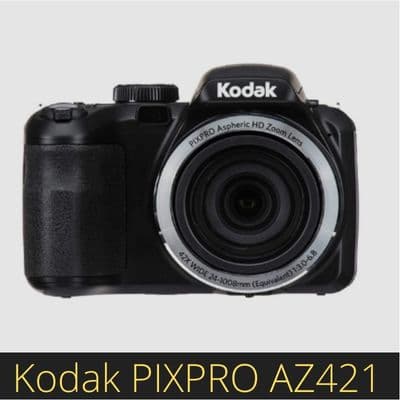
Good Build Quality
Considering how reasonably priced this camera is, it has an excellent overall build quality. It weighs around one pound and measures 3.3×4.4×3.2 inches, an industry average. The camera’s light payload also means that you can easily and quickly mount the camera to almost all kinds of tripods.
Easy to Use LCD Screen
At the back, there’s a 3-inch LCD screen that’s clear, bright, and easy to see, even in low-light environments. The navigation menu is also easy to use and user-friendly. If you’re buying a sports camera for the first time, this is a great option because using this screen will be like using your smartphone. No manuals are required for you to understand how to work it.
Great Optical Image Stabilization
This is arguably one of the best things about this option. The camera’s optical image stabilization tech seamlessly helps you minimize interference and disruption via vibration and movement at decent zoom levels. With that said, if you’re zooming in to the max, you’ll want to use a tripod.
Crisp Image Quality
You can expect some of the clearest and sharpest image quality once you play around with the camera’s focus at high zoom levels. This is a great action camera for something like golf because of how clear it can get when you zoom in to the max. In addition, tweaking focus isn’t too complicated.
Sufficient Video Quality
When it comes to its video capabilities, the average 720p video resolution standards have been met by Kodak. Yes, many others give 1080p at this price, but you’ll be getting grainy image quality with most of those alternatives.
Specifications for Kodak Pixpro AZ421
| Sensor | CCD sensor |
| Resolution | 16.15 MP |
| Shutter Speed | 1/2000 |
| ISO | 80-3200 |
| Video | HD up to 30fps |
Main Features
- 42x optical zoom range
- 15 megapixels CCD sensor
- 24mm wide-angle lens
- Optical Image Stabilization (OIS)
Our Take
The AZ421 is a solid option for entry-level users. It’s simple to use, and its various post-editing features make editing enjoyable. But its battery life may be insufficient if you need to cover long sporting events.
5. Best Panasonic Camera for Sports Photography – Panasonic LUMIX FZ300
The Panasonic LUMIX FZ300 (also known as the FZ330) is a rugged bridge camera that’s great for outdoor use. Equipped with an exceptional 24x zoom lens, it will allow you to get super close to the action. Here are some of its key specifications.
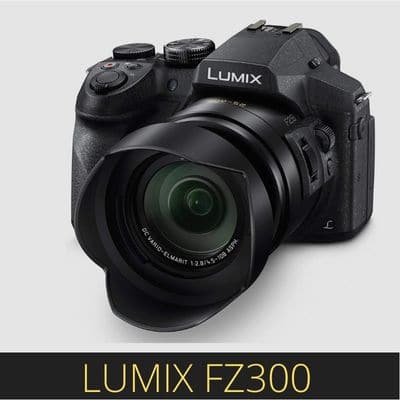
Quality Overall Design
The Lumix FZ300 has an SLR design style. It has a fixed lens that’s the same size as the compact zoom lens features you’ll find in most consumer models. The camera weighs about one and a half pounds and measures 3.6×5.2×4.6 inches. However, what sets this camera apart from the rest is its fixed f2/8 lens that covers a 25-600mm range.
Provides Plenty of Control
The camera has numerous physical controls. There’s a manual focus dial and zoom rocker on the camera’s left side. There’s also a designated button that allows you to toggle between autofocus with macro-shooting range and standard autofocus. The top plate has a mechanical release for its pop-up flash feature.
Simple User Interface
There’s a 4-way directional pad on the right side of the LCD monitor, which has a Menu/Set button at the center. You can use the directional presses for menu navigation and to set white balance, ISO, focus area, and drive mode. The additional rear control functions include Play, Display, and Fn3 (which you can use to activate Q.Menu and delete stills during playback).
Offers Great Image Quality
The FZ300 camera supports Panasonic’s 4K Photo mode. It only captures 8mp stills at 30fps, but it allows you to do this at high shutter speeds and at the narrow 4:3 aspect ratio many still photographers like.
Adjustable Touch-Responsive LCD
The rear display is a touch-responsive LCD screen. Furthermore, it can swing out and rotate to face straight ahead or straight down. You can use it to capture your own sporting moments as well as give interview subjects an idea of how they’ll look in the frame. You can use the touch functionality to activate on-screen controls and navigate menus.
Specifications for Panasonic LUMIX FZ300
| Sensor | MOS sensor |
| Resolution | 12.1 MP |
| Continuous Shooting Speed | Up to 12fps |
| Shutter Speed | 1/4000 |
| ISO | 100-6400 |
| Video | 4K up to 30fps |
Main Features
- Leica DC Vario-Elmarit 25-600mm zoom lens
- 1-megapixel high-sensitivity MOS sensor
- Five-axis hybrid optical image stabilization
- 1,440k-dot OLED Live View Finder
Our Take
The Panasonic LUMIX FZ300 is a tough camera that’s excellent for heavy use outdoors. Like many bridge cameras on this list, it has an impressive zoom range and is affordable. But its low resolution may make it unsuitable for you if you intend to print your photos after events.
6. Fujifilm X-T4 Mirrorless Camera – Best Mirrorless Camera:
The Fujifilm X-T4 is a mirrorless camera that’s excellent for still and motion photography. With in-built image stabilization and superb autofocus, you can easily keep up with fast-moving subjects and capture unforgettable moments. Here are some of its specifications.
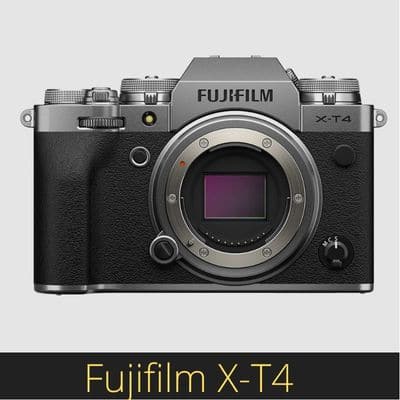
Solid Build Quality
The Fujifilm X-T ethos revolves around bold, analog-style dial features at the top dedicated to things like exposure compensation, shutter speed, and ISO. The X-T4 installment is no different. The camera has a solid overall build with analog-like dials that are charming and methodical.
Weatherproof Capabilities
Besides the camera’s excellent build quality, it also has a weather-sealed, full-metal body solid as a rock. This metal build means you can use it in almost any kind of weather. It’s slightly heavier and larger than its predecessor, the X-T3, because of its new IBIS unit. However, it’s still way lighter than most high-grade DSLR cameras.
Long Battery Life
The camera’s big handgrip houses a huge battery unit that provides more power than the battery in its predecessor did. In Economy mode, you can take up to around 600 shots. Furthermore, a USB-C port gives you access to on-the-go charging.
Improved Handling
The X-T4 has a slightly bigger handgrip than the X-T3, meaning better handling. Because the manufacturer had a lot more room to work with, there’s also now a new vertical grip you can choose to attach to the camera.
Easy to Use Interface
When you want to change exposure when taking videos, you can use the rear and front clicked control dials. You can easily make these changes using the device’s touchscreen and during capture. You can also use the touchscreen interface to navigate different menus and settings easily.
Specifications for Fujifilm X-T4 Mirrorless Camera
| Sensor | X-Trans (APS-C) CMOS sensor |
| Resolution | 26.1 MP |
| Continuous Shooting Speed | Up to 15fps |
| Shutter Speed | 1/8000 |
| ISO | 160-12800 (expandable 80 to 51200) |
| Video | 4K up to 60fps |
Main Features
- Five-axis sensor-shift image stabilizer
- 1 megapixel (APS-C) X-Trans CMOS 4 sensor
- 69 million dots OLED color viewfinder
- Large capacity battery
Our Take
The Fujifilm X-T4 is a brilliant camera for sports photography. Nonetheless, while it has many excellent perks, they come at a considerable cost. But if the price tag isn’t a concern, it’s one of the best mirrorless cameras for sports photography.
7. AKASO EK7000 Pro 4K Action Camera – Best Compact Camera
The Akaso EK7000 Pro 4K is an action camera perfect for outdoor sports and watersports. Built for the sports enthusiast on the move, it comes with handy accessories that allow you to carry it with you wherever you go easily. Here are some of its specifications.
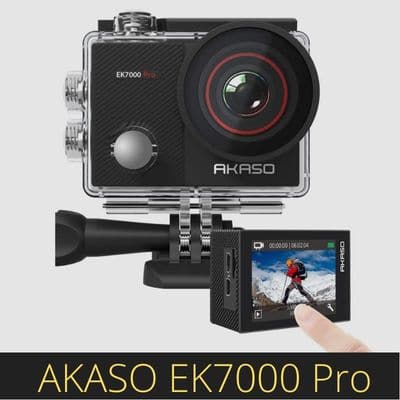
GoPro Design Style
The AKASO EK7000 looks a lot like a GoPro action camera. It looks exactly how one would expect an action cam to look. It’s a compact camera measuring 2.25×1.5×1.0 inches. The lens takes up around a quarter of the camera’s front-facing real-estate, with a red dot punctuated around its edge.
Waterproof Capabilities
One of the best things about this action camera is its waterproof casing manufactured using clear plastic. The case has a black casp with silver buttons at the top that helps push down the actual buttons on the camera when pressed. The casing means that you can use it in almost any kind of weather, which is ideal for a sports photography camera.
Wireless Connectivity
You’ll have access to a square-inch remote control you can use to control the camera wirelessly. This simple remote control has a grey button for capturing video and a red button for taking photos. The control also has a loop which you can use to help attach the remote control to something.
Simple Setup Process
It has a straightforward initial setup process. After a fairly conventional start-up procedure (time zone, date, language, etc.), and once you’ve inserted your micro-SD-card, you’re ready to record videos and take photos of your sporting moments.
Clear Photo Quality
You can use this camera to take pictures with resolutions ranging from 4mp to 16mp. The photo modes available include time-lapse, continuous lapse, burst and auto mode. All the photos you take will look great in almost any light. With this option, all you’ll need to do to get great images is point and shoot.
Specifications for Akaso EK7000 Pro 4K Action Camera
| Sensor | CMOS sensor |
| Resolution | 16 MP |
| Video | 4K up to 25fps |
Main Features
- Waterproof up to 130ft (40m)
- Adjustable viewing angle
- 2-inch touch screen display
- Electronic image stabilization (EIS)
Our Take
The Akaso EK7000 Pro is an inexpensive and user-friendly camera, making it great for beginners. If you’re learning the ropes of sports photography and looking for a budget action camera, it’s a worthwhile choice.
8. COOAU Native 4K – Best Budget 4K Camera
The COOAU is an inexpensive action camera ideal for watersports. Whether you’re going diving, swimming, or surfing, you’ll be able to carry it with you because it’s compact and waterproof up to 131ft (40m). Here are some of its key specifications.
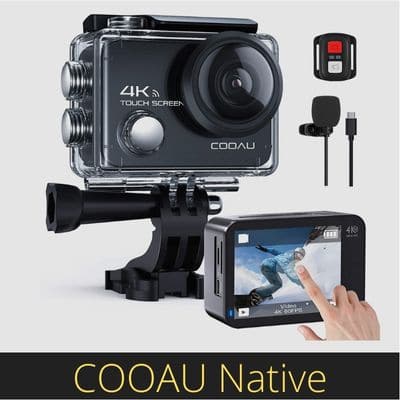
Solid Overall Design
The Native 4K is a black, well-built camera with high-end plastics. At first glance, it looks a lot like your ordinary action cam. It weighs about 1.250lbs and measures 9.3×4.9×3 inches. There are two LEDs at the front for turning it off/on and recording, a lens, and a button for mode changing.
Long Battery Life
Its 1350mAh lithium-ion battery is bigger than what you’ll find in most cameras at this price point. Furthermore, this camera comes with two batteries and a separate one for its remote control. You can record in 1080p at 30fps for up to 120 minutes and record video in 4K for around 60 minutes.
Fantastic Image Stabilization
You can improve high smooth videos by using the camera’s RSC function and Intelligent EIS stabilization. You can also stabilize footage using the EIS stabilization setting. You’ll find both these interesting features in the menu. However, you might need the help of a gimbal if you want to take full advantage of the camera.
Clear Image Quality
You can use this camera to capture up to 20mp stills, making good quality photographs. You can change exposure and ISO to help ensure the pictures come out great. Additionally, the camera’s 170-degrees angle offers an enlarged view so photos and images can showcase worthy realism.
Great Video Quality
You can record high-end videos in several different resolutions and good bitrate. You can record videos up to 4k-60fps. Furthermore, the external mic that comes with the camera helps ensure great audio quality on your video content.
Specifications for COOAU Action Camera
| Screen | 2.0 inch |
| Resolution | 20 MP |
| Video | 4K up to 60fps |
Main Features
- Waterproof up to 131ft (40m)
- Sensitive IPS touch screen
- Electronic image stabilization (EIS)
- External mic with noise reduction
Our Take
There’s not much to separate the COOAU action camera and other action cameras on this list. But one feature sets apart the COOAU from the other action cameras – it can record 4K video at up to 60fps. So if you want to record quality video in 4K, it’s your best bet.
9. Sony Alpha A6600 Mirrorless Camera – Best Beginner Mirrorless Camera:
The Sony Alpha A6600 is a mirrorless camera perfect for sports photography. With fast autofocus and a unique real-time tracking system, you won’t have to worry about fast-moving subjects moving out of the frame. Here are some of its key specifications.
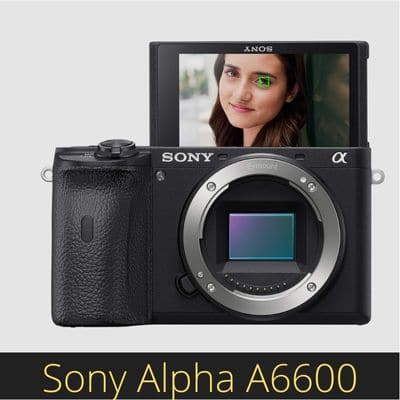
Great Image Quality
The camera’s high-end processor and sensor help ensure the production of high-quality images. The default color output on images looks outstanding and helps illustrate how far Sony has come with cameras. The camera also performs well at high ISO values, so it’s perfect for beginners.
Impeccable AutoFocus Functionality
Sony has installed its latest autofocus tracking tech on this camera. This helps make it a competent sports photography camera for capturing fast-action sports footage. However, some aspects can make action and sports photography a bit frustrating, but autofocus isn’t one of them.
Clear Videos
You can expect very detailed 4K footage when using this camera. Not only will this camera offer you great 4K video footage, but it also has a healthy set of capture profiles, including Log options. Also, the AF tracking is good when recording video, but you’ll need to tweak touchscreen behavior a bit.
Good Handling
The redesigned grip feature makes the camera easier to handle. This is one of the new feature designs by Sony that help make the a6600 more functional.
Long Battery Life
The a6600 camera’s battery has a CIPA rating, meaning you can get more than 800 shots on just one charge, which is really high. However, that is basically DSLR camera territory. The newly redesigned grip feature helps hide the NP-FZ100 battery.
Specifications for Sony Alpha A6600
| Sensor | APS-C Exmor CMOS Sensor |
| Resolution | 24.2 MP |
| Continuous Shooting Speed | Up to 11fps |
| Shutter Speed | 1/4000 |
| ISO | 100-32000 (expandable 50 to 102400) |
| Video | 4K up to 30fps |
Main Features
- 5-axis in-body optical image stabilization
- 425 phase-detection autofocus points
- Real-time autofocus tracking system
- Long-lasting Z-series battery
Our Take
The Sony Alpha A660 is undoubtedly one of the best beginner mirrorless cameras for sports photography. Unfortunately, at $1,850, it’s the costliest camera on this list. But if you’re looking to go from beginner to pro, it’s a worthwhile investment.
10. OLYMPUS Tough TG-6 Waterproof Camera – Best Compact Camera
The Olympus Tough TG-6 is a compact camera great for extreme sports like diving, mountain biking, and skateboarding. True to its name, it’s a robust camera that thrives in harsh conditions. Here are some of its specifications.
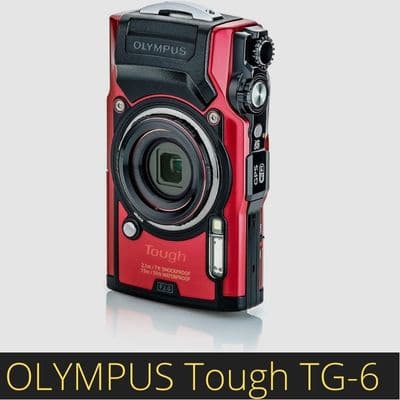
Protective Glass Construction
The LCD screen at the rear has a protective, dual-pane glass construction for enhanced anti-fogging. It’s thick glass protection that can withstand quite a lot of punishment. Your smartphone or tab would be in shock at how much punishment that casing can take.
Weatherproof
Not only is the camera water-resistant up to 15 meters underwater, but it’s also dustproof too. This camera is almost indestructible because it is freezeproof to 10 degrees Celsius and crushproof up to 220-lbs.
Practical LED Flash
The camera has a surprisingly practical LED flash, which you can manually control in eighteen different increments from 1/64 up to full power. Furthermore, the LED lamp provides more natural-looking light.
Interesting Recording Modes
The Tough TG-6 has many high-speed recording modes. You capture 4K video at 30 frames per second and record video 1080p video footage up to 120 frames per second, 360p at 48 frames per second and 720p at 240 frames per second.
Specifications for Olympus Tough TG-6
| Sensor | BSI CMOS sensor |
| Resolution | 12 MP |
| Continuous Shooting Speed | Up to 20fps |
| Shutter Speed | 1/2000 |
| ISO | 100-12800 |
| Video | 4K up to 30fps |
Main Features
- Waterproof up to 50ft (15m)
- High-speed F2.0 wide-angle lens
- 4X optical zoom
- Microscope Modes
Our Take
The TG-6 is a compact camera primarily built to take on extreme environments. As a result, it’s costlier than many other compact cameras. But if you’re looking for a durable camera for your next extreme adventure, the price may be worthwhile.
Best Camera for Sports Photography: Buying Guide for Beginners
There isn’t a one-size-fits-all sports photography camera for beginners. Before you purchase one, here are some essential factors you should consider.
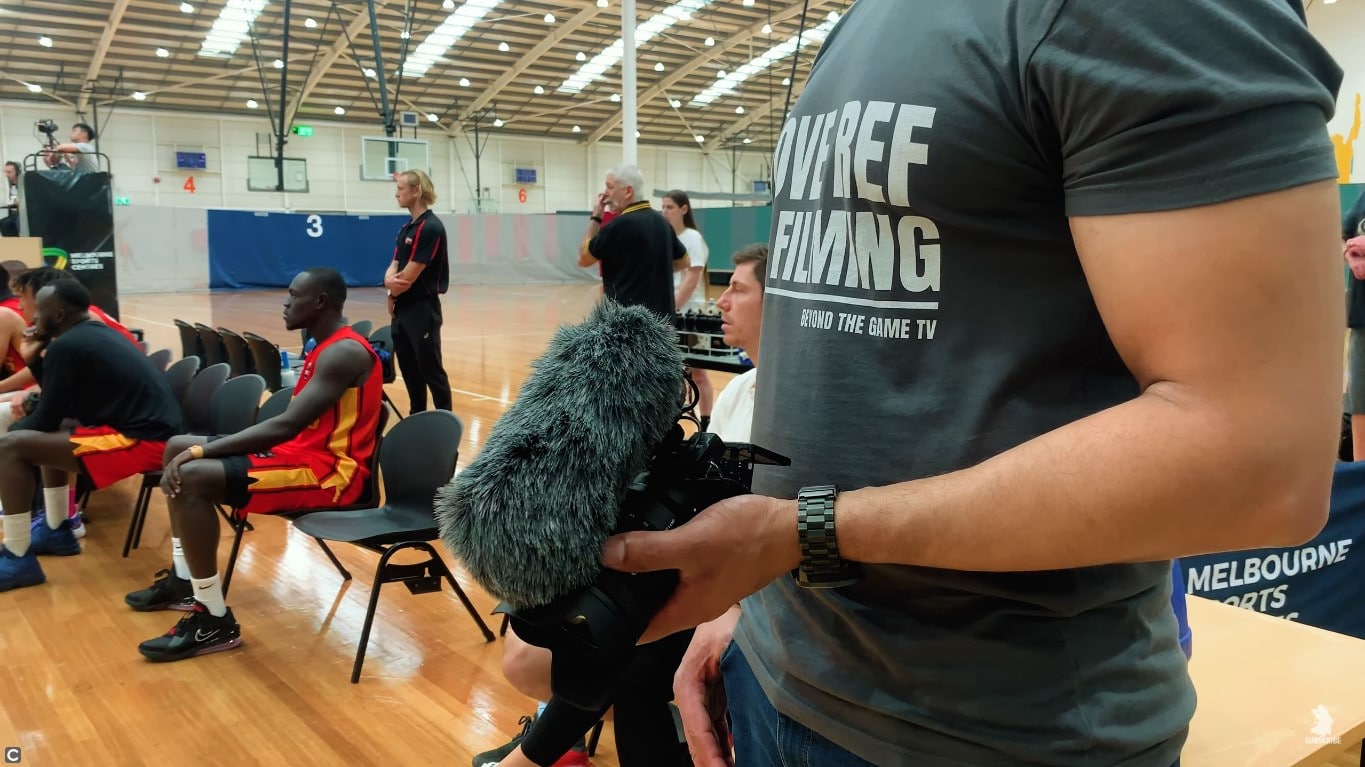
Burst Mode
Things happen within the blink of an eye in sports. Within seconds, a keeper may make a magnificent save, or a shooting guard may make a decisive three-point shot to win a game just before the final buzzer. To capture these critical moments, you’ll need a camera that can take multiple shots in a short period.
With a camera with a fast burst mode (also known as continuous shooting mode), you’ll have a higher chance of capturing time-sensitive moments because you’ll be able to choose from several shots after your event.
Mirrorless cameras usually have faster burst speeds than other camera types, but several DSLR cameras have decent burst speeds too.
Buffer Size
While a fast burst rate is a crucial feature you should look out for when shopping for a sports photography camera, you should also pay attention to the buffer size
A buffer is a temporary holding area for your pictures. A camera with a large buffer can allow you to take multiple shots before the camera runs out of storage and stops taking pictures.
Autofocus System
Subjects are constantly on the move in most sports, and they move fast. For example, tennis players keep shuttling quickly from one end of the tennis court to the other, and Formula 1 drivers can reach top speeds of up to 372.5km/h(231.4mph). To keep up with fast-moving subjects, you’ll need a camera with an excellent autofocus system.
When shopping for a sports photography camera, look out for one with fast autofocus so that you stay glued to subjects no matter how fast they’re moving.
And if you aren’t on a tight budget, look for a camera with advanced autofocus features like subject tracking and face tracking for even better results.
Shutter Speed
Have you ever captured several pictures of a moving subject only to check your photos later and find most of them are blurry? If yes, your shutter speed was probably too slow.
When buying a sports photography camera, ensure you get one with a fast shutter speed to prevent motion blur and increase your chances of capturing great action shots.
Image Stabilization
Besides a fast shutter speed, a sports camera with image stabilization can help to eliminate blurriness in your shots by reducing camera shake.
As a result, image stabilization can be beneficial if you’re shooting in windy conditions or while on the move on a skateboard, bicycle, or motorcycle. It can also come in handy if you’re tracking a fast-moving subject that you need to keep steady in your viewfinder.
Zoom Range
At many sports events, you may not be able to get too close to the action. As a result, you’ll need a camera that can draw you near the action.
Look for a sports photography camera with a good zoom range that will allow you to zoom in on distant subjects at critical moments.
Ergonomics
Ergonomics is often associated with comfort. But when it comes to cameras, ergonomics involves more than just comfort.
Besides comfort, look for a camera with well-placed controls. A camera with well-placed controls will allow you to quickly adjust settings if necessary without having to take your eye off the viewfinder.
Battery Life
When shooting at a sports event, you’ll likely use features like subject tracking and continuous shooting. These features can deplete your battery life fast.
If you often cover long sporting events, look for a camera with good battery life so that you don’t have to worry about running out of charge.
Build Quality
As a sports photographer, you may need to shoot in extreme conditions. Whether it’s very dusty or there’s inclement weather, you’ll need to keep rolling.
Therefore, when shopping for a sports camera, look for one with a rugged build. Also, look for a waterproof camera, especially if you’re a watersports enthusiast.
And if you’re an extreme sports enthusiast looking for a camera for your next adventure, get one that can withstand drops and knocks.
ISO Sensitivity
A camera’s ISO determines its sensitivity to light. You’ll typically want a camera with a high ISO for sports photography. A camera with a high ISO will capture more light and allow you to take brighter images. As a result, it can come in handy when shooting in poorly-lit areas like dim gyms.
Nonetheless, while a camera with a high ISO level can allow you to shoot in low light conditions, some cameras produce a lot of grain when shooting at high ISO levels. Therefore, before buying a sports camera, check out its image quality when shooting at its maximum ISO.
Viewfinder
Nowadays, we’re used to taking photos using LCD screens because of our smartphone cameras. But for sports photography, it isn’t advisable to use an LCD screen. Instead, you should use a viewfinder. A viewfinder will help you compose your shots better and keep track of fast-moving subjects.
While there are several other factors to consider when buying a sports photography camera, these are the most important ones you should remember.
5 Sports Photography Tips for Beginners
Now that you know some of the best sports photography cameras for beginners and the factors to consider before buying a sports camera let’s move on to the exciting part – capturing photos!
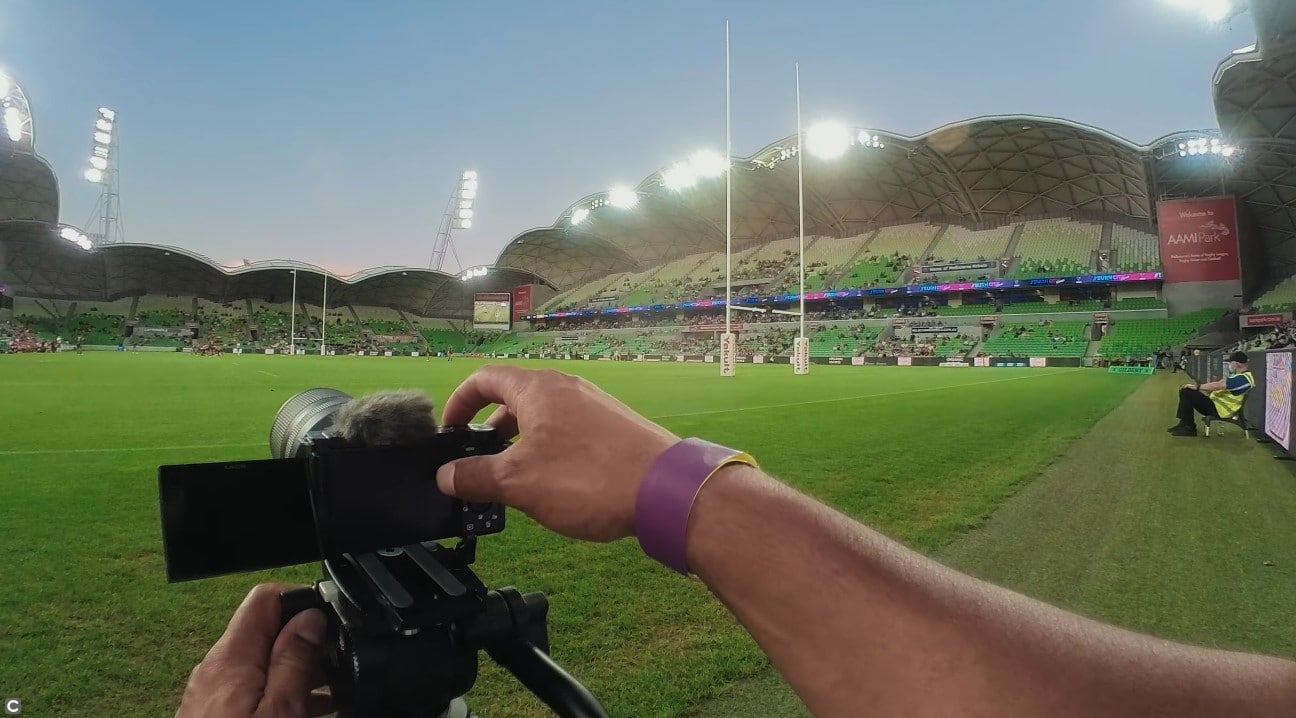
Whether covering an outdoor sports event or shooting underwater, here are five tips that can help you become a better sports photographer.
1. Understand the Sport
Learn the rules of the sport you’re planning to cover. Game-changing events can happen within the blink of an eye in sports – so understanding the rules of the game can help you position yourself at the right place, at the right time to capture a fantastic shot.
2. Check the Background
When shooting sports photographs, the athlete should be the hero of your shots. Before you start shooting, check whether the background is clear and free from distractions like conspicuous advertising or flashy colors. If necessary, move to a spot with no distractions so that the athlete remains the focal point in your images.
3. Set the Autofocus
Most cameras are usually set to single autofocus mode (AF single) by default. If you leave your camera in single autofocus mode and start shooting, you’ll struggle to keep up with fast-moving subjects.
Therefore, before you start shooting, ensure you’ve set your camera to continuous autofocus mode (AF continuous). When put on continuous autofocus mode, your camera will keep track of subjects even if they move around within the frame.
4. Get Close to the Action
When shooting at sports events, you’ll want to get as close as possible to the action because pictures that fill your frame will look much better. Use a camera with a large zoom range to get close to the action.
Alternatively, if your camera doesn’t have a large zoom range, don’t worry. You can still use your camera or a photo editing tool like Photoshop to crop your images and get closer to the action. While doing this may take more steps, the extra steps are worthwhile because you’ll get better pictures.
5. Learn Your Camera Settings
Cameras have a lot of settings. If you aren’t familiar with your camera settings and spend a lot of time fiddling with them during sports events, you could miss out on game-changing moments.
Learn your camera settings to ensure you don’t miss out on crucial moments. For starters, ensure you learn the relationship between your camera’s shutter speed, lens aperture, and ISO. These three settings control your camera’s exposure. Taking the time to learn how each of these three settings works can significantly improve your photography and take you from a beginner to an intermediate sports photographer in no time.
Here’s a helpful video explaining the relationship between shutter speed, lens aperture and ISO:
Finally, just like athletes, ensure you practice frequently to become a better sports photographer.
Frequently Asked Questions
What Equipment Do I Need for Sports Photography?
You’ll need a good sports photography camera and a fast memory card to store your images quickly. You’ll also need a camera strap to secure your camera and protect it from falling. While optional, you may also need a telephoto lens and a monopod. A telephoto lens will help you capture distant subjects clearly. Meanwhile, a monopod will relieve you from having to hold your camera for long spells and keep it stable while shooting.
Is a Full Frame Camera Better for Sports Photography?
No. While a full-frame camera may offer better low-light performance, dynamic range, and image quality than a crop sensor camera, the differences between pictures taken with both sensors aren’t significant.
What ISO Should I Use for Sports?
There isn’t a specific ISO you should use for sports. The right ISO will depend on the lighting conditions. For example, when shooting on a bright sunny day, you can use an ISO of 400 as a starting point. On the other hand, when shooting in a dimly lit gym or under overcast conditions, you should set your ISO to 1,600 or higher. Nonetheless, as a rule of thumb, shoot at the lowest ISO possible to prevent noise in your photos.
Are Zoom Lenses Good for Sports Photography?
Yes. Zoom lenses will allow you to get closer to subjects. They’ll also offer you more flexibility than prime lenses since you won’t need to keep changing lenses. Instead, you’ll be able to adjust the focal length depending on the subject’s distance.
Is a 300mm Lens Good Enough for Sports Photography?
Yes. A 300mm lens is ideal for covering sports like baseball, soccer, and football, where you’ll most likely be far from the subject. It will allow you to zero in on your subjects and make them the focal point of your image because it has a shallow depth of field.
Parting Shot
While the saying “the best camera for photography is the camera you have” may be true, it won’t hold water when it comes to sports photography. As a sports photographer, you’ll need a camera with a high shutter speed, fast autofocus, good image stabilization, and a rapid burst rate to keep up with the action. You’ll also need a camera that can withstand harsh conditions, especially for shooting extreme sports.
If you’re on a tight budget, consider getting the Canon EOS Rebel T7. At just below $600, it’s one of the best budget cameras for sports photography beginners, and it’s great value for money. On the other hand, if you’re ready to spend more, consider getting the Sony Alpha A6600. At $1,850 for only the body, it’s the priciest camera in this guide, but its top-notch performance and perks make it well worth the cost.
